Collections Highlights
The original collection bequeathed by Dr William Hunter has grown substantially and The Hunterian collections now encompass over one million items. There are many highlights to discover and a small selection is highlighted here.
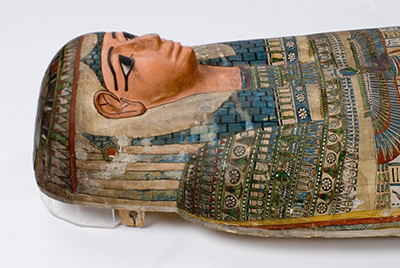 Lady Shep-en-hor
Lady Shep-en-hor
The Hunterian's famous mummy, Lady Shep-en-hor, is over 2500 years old and comes from Thebes in southern Egypt. The ancient Egyptians preserved bodies to help the deceased make the journey to the afterlife. The hieroglyphs on the brightly painted coffin are spells and charms to keep her safe.
Location: Main Gallery, Hunterian Museum
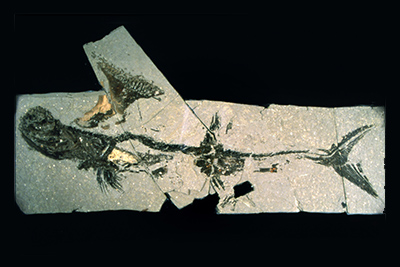 Bearsden Shark
Bearsden Shark
The 'Bearsden Shark' is the most complete shark of its age. Found by Stan Wood while walking his dog by a stream in the north west of Glasgow, this 330 million year old shark has a strange, toothed fin-spine behind its head. We can only guess at its purpose.
Location: Main Gallery, Hunterian Museum
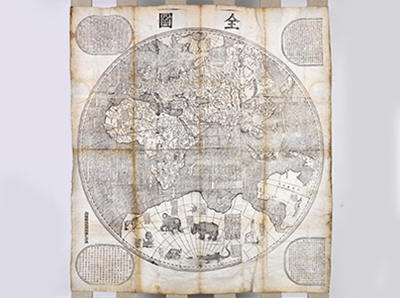 Chinese Map of the World
Chinese Map of the World
The Hunterian's copy of this rare and fabulous map of the world was prepared for the Chinese Emperor Kangxi in 1674 by Jesuit missionary Ferdinand Verbiest. It presents a unique summary of global geographic knowledge at this time. Our copy was in William Hunter's original collection and was one of the earliest known examples of this map to reach Europe.
Location: Main Gallery, Hunterian Museum
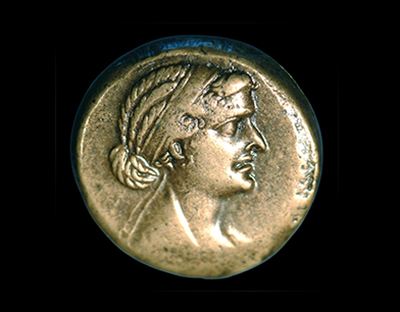 Cleopatra Coin
Cleopatra Coin
This is the best example in the world of a Cleopatra coin. Cleopatra VII was one of the world’s most powerful women and she personally approved this portrait. Famed for her intelligence, charisma and political skills, Cleopatra was the last of the Egyptian Pharaohs. She ruled Egypt with her brother Ptolemy XIII, but went on to defeat him with the help of Julius Caesar. After Caesar’s assassination she returned to Egypt and fell in love with Mark Antony. Mark Antony was defeated in 31 BC by his rival Octavian and committed suicide. Cleopatra followed suit, choosing death by snakebite.
Location: Main Gallery, Hunterian Museum
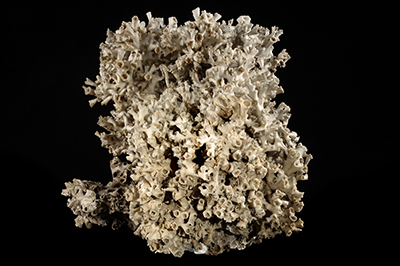 Deep Sea Coral, Lophelia Pertusa
Deep Sea Coral, Lophelia Pertusa
This coral was 'caught' by a line fisherman from 22 metres depth between the islands of Coll and Barra off the west coast of Scotland. It is not just the warm shallow tropical seas that are associated with reef formation. Surprisingly, coral reefs are actually found on the deep ocean bed in cold water. Massive structures called the 'Darwin Mounds' off the north of Scotland are the most important coral reefs in British waters. Scientists are concerned that deep trawl fishing is severely damaging this important marine ecosystem.
Location: Main Gallery, Hunterian Museum
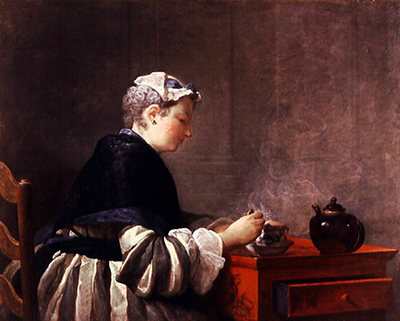 A Lady Taking Tea
A Lady Taking Tea
Jean Simeon Chardin, 1735
Oil on canvas
This beautiful masterpiece by the French 18th-century painter, Jean-Siméon Chardin, was voted Scotland's second favourite painting by readers of The Herald newspaper. An evocative image of a lady drinking tea, it probably depicts Chardin's wife, Marguerite Saintard, who died only two months after the painting was completed. Acquired by our founder, Dr William Hunter (1718-1783), it is part of a small but significant group of Old Master paintings that includes works by Rembrandt and Rubens.
Location: Hunterian Art Gallery
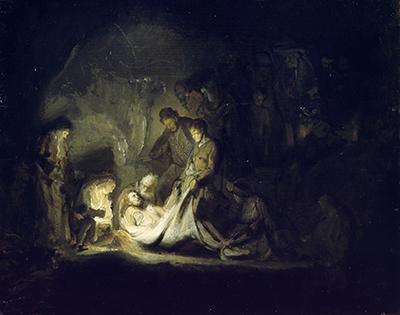 The Entombment
The Entombment
Rembrandt van Rijn, c. 1624
Oil on panel
This moving painting is an almost monochrome oil painting from Rembrandt's early years in Amsterdam. It shows the burial of Christ taking place deep inside the rock tomb, by torchlight. It was a personal work which the artist kept in his living room, and he seems to have painted it as an example of his skill in painting devotional works.
Location: Hunterian Art Gallery
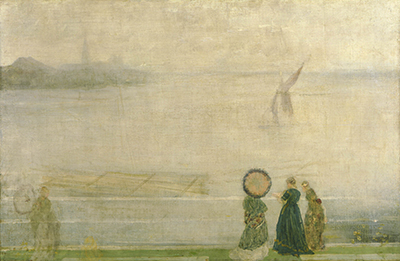 Battersea Reach from Lindsay Houses
Battersea Reach from Lindsay Houses
James McNeill Whistler, c. 1864 - 71
Oil on canvas
The Hunterian houses the largest public display in the world of the art of the innovative American-born painter, printmaker, designer and writer, James McNeill Whistler (1834-1903). This view of the Thames and the industrial warehouses of Battersea is characteristic of Whistler's unconventional choice of subject matter, impressionistic interpretation of landscape, and interest in the art and motif of the Far East.
Location: Hunterian Art Gallery
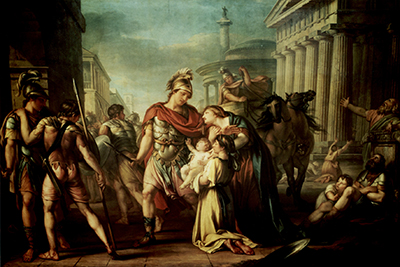 Hector’s Farewell to Andromache
Hector’s Farewell to Andromache
Gavin Hamilton, c. 1775 - 80
Oil on canvas
Hamilton, one of the most celebrated artists to have studied at the University of Glasgow, spent the majority of his career in Rome. He was also a leading antiquarian and picture dealer, responsible for the discovery of the Warwick Vase, now in Glasgow’s Burrell Collection. This painting is a key example of Hamilton's role as one of the founders of European Neoclassicism. It shows a predilection for themes taken from Greek history that would promote the heroic values believed to be behind the success of Greek civilization; an admiration for the art of classical antiquity; and a desire to be as historically accurate as possible when describing the costumes and buildings of Ancient Greece.
Location: Hunterian Art Gallery
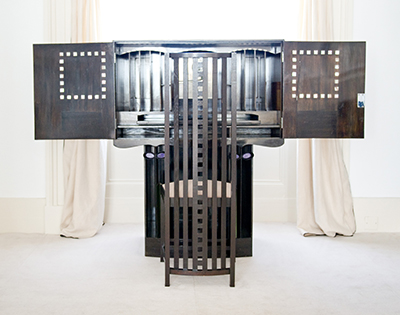 Writing Cabinet
Writing Cabinet
Charles Rennie Mackintosh, 1904 - 05
Ebonised mahogany and sycamore, with peartree, mother-of-pearl, ivory, glass and silvered metal
This was Mackintosh's personal writing cabinet. It was based on a design for his important patron, Walter Blackie, at The Hill House, and is one of the most luxurious pieces he designed, using a range of materials and subtle tapering and geometric forms. The cabinet was sold at auction in the late 1970s for a world-record price for a piece of 20th century furniture. A successful appeal secured it for the University and it is now on display in the studio of The Mackintosh House.
Location: The Mackintosh House, Hunterian Art Gallery
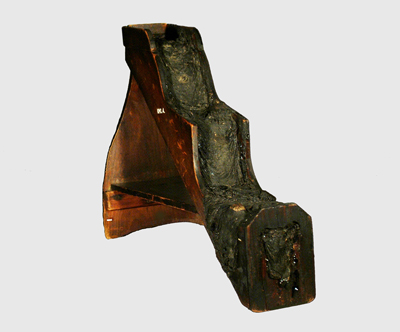 Pitch Glacier Experiment
Pitch Glacier Experiment
Sir William Thomson, Baron Kelvin of Largs, 1887
Wood and pitch
The Hunterian holds much of Lord Kelvin’s original experimental apparatus, created during his 53-year tenure at the University of Glasgow. In the later 1880s Kelvin was intrigued by the theory that the atmosphere around us consists of tiny particles that are possessed of energy, and thus can exert force upon larger matter. This demonstration piece, the ‘creeping pitch glacier’, is composed of cobbler’s wax positioned on a stepped wooden support. The pitch glacier was used to show that small, persistently applied forces are sufficient to produce unlimited changes in the shape of a substance over long periods of time. The experiment is still live after over 120 years. This ingenious model gives new meaning to the phrase ‘glacial progress’.
Location: Hunterian Museum
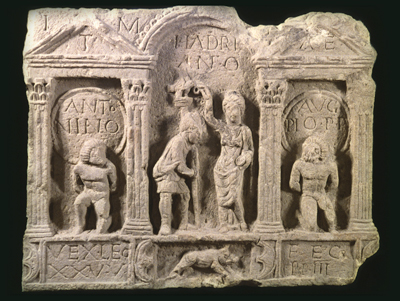 Inscribed Distance Slab of the Twentieth Legion
Inscribed Distance Slab of the Twentieth Legion
Roman, Antonine Wall, Scotland, c.142–43 AD
Sandstone
The Antonine Wall stretched some 60 km from the Firth of Forth to the River Clyde and was the most northerly border in the Roman Empire. This powerfully carved distance slab from Hutcheson Hill, Bearsden, symbolises Roman victory over the Caledonian tribes. The central female figure is probably Britannia who congratulates the Roman troops on their success. Designed to record lengths or ‘distances’ of the wall completed by each legion, the distance slabs celebrated the Roman military victories that preceded the construction of the Antonine Wall. Placed on the south side of the wall and facing the empire, the sculpted scenes served as powerful political propaganda. 18 slabs survive and all but two are in The Hunterian’s collections.
Location: Hunterian Museum

